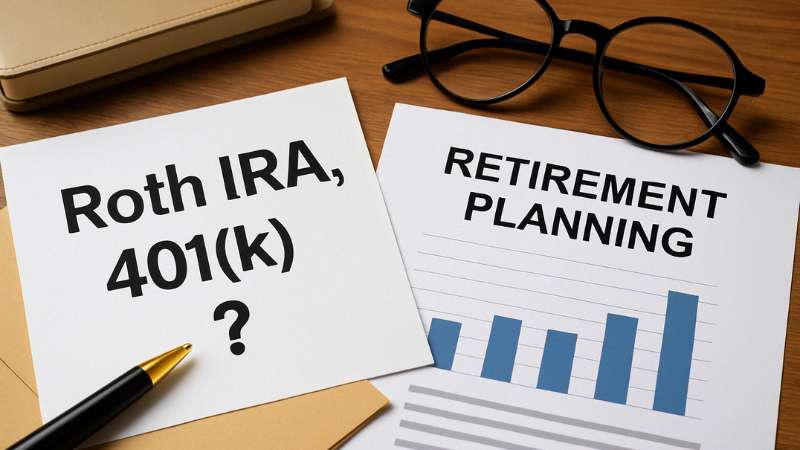
If you’ve ever stared at a benefits form or investment platform thinking, “Should I check Roth IRA? Or is it 401(k)? Or do I just hope for the best?”—you’re not alone.
Most people know they should be saving for retirement. But the moment you dive into options, you’re hit with an alphabet soup of accounts, limits, taxes, penalties, and terms no one explained in school.
This guide is for anyone who wants a straightforward explanation of tax-advantaged accounts and how to think about their retirement savings, no matter your age or income.
Let’s break it down.
What Is Retirement Planning, Really?
Retirement planning simply means figuring out how to support yourself when you’re no longer working full-time. It’s about:
- How much money you’ll need
- Where that money will come from
- How to make your money grow in the meantime
Retirement planning usually includes:
- Estimating future expenses
- Using tools like Roth IRAs and **401(k)**s to save
- Factoring in Social Security or pensions (if you’re lucky)
The earlier you start, the more time your money has to grow—and the less you’ll need to save each month.
Roth IRA vs. 401(k): What’s the Actual Difference?
Here’s the core difference: it’s about when you pay taxes.
| Feature | Roth IRA | 401(k) |
|---|---|---|
| Contributions | After-tax (you pay taxes now) | Pre-tax (you pay taxes later) |
| Withdrawals in retirement | Tax-free (if rules met) | Taxed as income |
| Contribution limits (2024) | $6,500/year (or $7,500 if 50+) | $23,000/year (or $30,500 if 50+) |
| Income limits | Yes (IRS income limits) | None |
| Employer match | Not available | Often included |
| RMDs (Required Withdrawals) | None | Yes, starting at age 73 |
What Is a Roth IRA?
A Roth IRA is a retirement account that you fund with money you’ve already paid taxes on. That means when you retire, you can withdraw both your original contributions and your earnings completely tax-free—as long as you’re 59½ and the account is at least five years old.
📊 According to the Investment Company Institute, about 28% of U.S. households owned a Roth IRA as of 2023 [https://www.ici.org/statistical-report/retirement-assets].
Roth IRA Contribution Limits (2024)
- $6,500 if you’re under 50
- $7,500 if you’re 50 or older
- You must earn less than $146,000 (single) or $230,000 (married) to contribute the full amount
What Is a 401(k)?
A 401(k) is an employer-sponsored retirement account that allows you to contribute pre-tax income. That means you don’t pay taxes now—only when you withdraw the money in retirement.
Many employers offer to match part of your contribution, which is essentially free money toward your future.
📊 According to Vanguard, the average 401(k) balance was $112,572 in 2023, but the median (more realistic for most people) was $27,376 [https://institutional.vanguard.com/content/dam/inst/vanguard-has-a-long/investment-approach/research/pdf/How_America_Saves_2023.pdf].
401(k) Contribution Limits (2024)
- $23,000 if you’re under 50
- $30,500 if you’re 50 or older
- No income limits
Why It’s Called “Tax-Advantaged”
Both Roth IRAs and 401(k)s are considered tax-advantaged accounts because they give you a break on taxes—just at different times.
- Roth IRA: pay now, withdraw tax-free later
- 401(k): skip taxes now, pay them when you retire
These tax benefits are what make them smarter than keeping all your savings in a checking or standard brokerage account.
What If I Can’t Max Out Both?
If you can only do one (which is most people), here’s a simple decision flow:
✅ Your employer offers a match?
Start with the 401(k)—contribute at least enough to get the full match.
✅ You expect to be in a higher tax bracket later?
Go Roth IRA—pay taxes now, skip them later.
✅ You’re early in your career?
Roth IRA is usually best—you’re likely in a lower tax bracket now than in the future.
✅ You want to save more than Roth allows?
Use both. Start with Roth, then go to your 401(k).
What Does This Look Like Month to Month?
Let’s say you can set aside $300 a month. You could:
- Put $150 into your 401(k) and get a $150 employer match = $300
- Put $300 into a Roth IRA
- Or split it between both (e.g. $150 into each)
The key is to automate your savings so it happens before you spend. Most employers and brokerages make this easy.
How Age (Not Just Income) Changes the Retirement Game
Your stage of life plays a huge role in how you should approach your retirement planning—regardless of your income or career path.
In your 20s and 30s, the priority is usually building the habit—even small contributions to a Roth IRA or 401(k) matter because of compound growth. This is the time to take advantage of Roth accounts, especially if you’re in a lower tax bracket. You’re investing in time more than cash.
By your 40s and 50s, your strategy shifts. With retirement closer on the horizon, the focus becomes increasing retirement savings rates, maximizing employer matches, and possibly adjusting your risk tolerance. You might consider increasing 401(k) contributions and even using catch-up contributions if you’re 50 or older.
For those in their 60s and beyond, it’s about decumulation planning—thinking through when to withdraw, managing Required Minimum Distributions (RMDs), and balancing withdrawals with Social Security and other income streams.
🧠 This naturally overlaps with the generational perspective:
Each generation is navigating retirement planning from a different point along this age-based path. As of 2025, Gen Z is just starting, Millennials are in the building phase, Gen X is playing catch-up, and Boomers are managing withdrawals. Your financial strategy will reflect your age—but understanding where your generation sits helps explain what you might be seeing or feeling about money right now.
Final Thought: You Don’t Need to Be a Finance Nerd
You don’t need to memorize tax codes or predict the stock market to make smart moves. But you do need to start.
“The best retirement account is the one you actually use—and the earlier you start, the easier it gets.”
Whether it’s a Roth IRA, a 401(k), or a little of both, the goal is to build momentum. Your future self—whatever generation you’re part of—will thank you.


